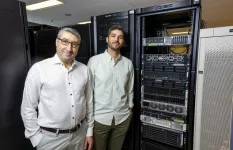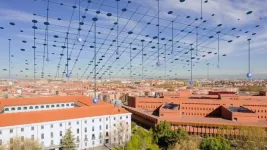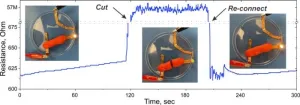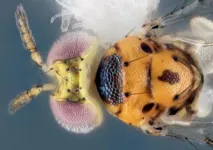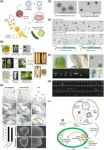(Press-News.org) Tomorrow’s workplace will be run on mind-boggling amounts of data. To make sense of it all, businesses, developers and individuals will need better artificial intelligence (AI) systems, better trained AI workers and more efficient number-crunching servers.
While big tech companies have the resources and expertise to meet these demands, they remain beyond the reach of most small and medium-sized enterprises and individuals. To respond to this need, a Concordia-led international team of researchers has developed a new framework to make complex AI tasks more accessible and transparent to users.
The framework, described in an article published in the journal Information Sciences, specializes in providing solutions to deep reinforcement learning (DRL) requests. DRL is a subset of machine learning that combines deep learning, which uses layered neural networks to find patterns in huge data sets, and reinforcement learning, in which an agent learns how to make decisions by interacting with its environment based on a reward/penalty system.
DRL is used in industries as diverse as gaming, robotics, health care and finance.
The framework pairs developers, companies and individuals that have specific but out-of-reach AI needs with service providers who have the resources, expertise and models they require. The service is crowdsourced, built on a blockchain and uses a smart contract — a contract with a pre-defined set of conditions built into the code — to match the users with the appropriate service provider.
“Crowdsourcing the process of training and designing DRL makes the process more transparent and more accessible,” says Ahmed Alagha, a PhD candidate at the Gina Cody School of Engineering and Computer Science and the paper’s lead author.
“With this framework, anyone can sign up and build a history and profile. Based on their expertise, training and ratings, they can be allocated tasks that users are requesting.”
Democratizing DRL
According to his co-author and thesis supervisor Jamal Bentahar, a professor at the Concordia Institute for Information Systems Engineering, this service opens the potential offered by DRL to a much wider population than was previously available.
“To train a DRL model, you need computational resources that are not available to everyone. You also need expertise. This framework offers both,” he says.
The researchers believe that their system’s design will reduce costs and risk by distributing computation efforts via the blockchain. The potentially catastrophic consequences of a server crash or malicious attack are mitigated by having dozens or hundreds of other machines working on the same problem.
“If a centralized server fails, the whole platform goes down,” Alagha explains. “Blockchain gives you distribution and transparency. Everything is logged on it, so it is very difficult to tamper with.”
The difficult and costly process of training a model to work properly can be shortened by having an existing model available that only requires some relatively minor adjustments to fit a user’s particular needs.
“For instance, suppose a large city develops a model that can automate traffic light sequences to optimize traffic flow and minimize accidents. Smaller cities or towns may not have the resources to develop one on their own, but they can use the one the big city developed and adapt it for their own circumstances.”
Hadi Otrok, Shakti Singh and Rabeb Mizouni of Khalifa University in Abu Dhabi contributed this study.
Read the cited paper: “Blockchain-based crowdsourced deep reinforcement learning as a service.”
END
Artificial intelligence grunt work can be outsourced using a new blockchain-based framework developed by Concordians
The costly, difficult process of training deep reinforcement learning models doesn’t have to be inaccessible to smaller players, say Ahmed Alagha and Jamal Bentahar
2024-09-18
ELSE PRESS RELEASES FROM THIS DATE:
Mental health challenges faced by children with cystic fibrosis are the focus of a major, multisite study led by UB
2024-09-18
BUFFALO, N.Y. — A University at Buffalo psychiatrist who has played a critical role in getting mental health screening and treatment integrated into routine care for adults and adolescents with cystic fibrosis (CF) has been awarded $3 million from the Cystic Fibrosis Foundation to focus on the mental health of children with the disease.
Led by UB and launched this summer, the new study is an outgrowth of The International Depression Epidemiological Study (TIDES), which began in 2014 and was the largest study of mental health in adolescents and adults with CF. As a result of TIDES, ...
UC3M and Universia obtain an ENIA Chair in artificial intelligence in data economy
2024-09-18
The Universidad Carlos III de Madrid (UC3M) is one of 22 institutions that have been selected by the Ministry for Digital Transformation and the Civil Service to create an ENIA Chair to further the development of artificial intelligence (AI)-based applications. The AImpulsa UC3M-Universia Chair, as it is called, will be the only one of its kind in Spain in the area of Data Economy and will collaborate with Universia-Banco Santander, through Santander Universities.
The ENIA Chairs' objectives, which depend on the Secretary of State for Digitalisation and Artificial Intelligence of the Ministry for Digital Transformation and ...
Why petting your cat leads to static electricity
2024-09-18
Anyone who has ever pet a cat or shuffled their feet across the carpet knows that rubbing objects together generates static electricity. But an explanation for this phenomenon has eluded researchers for more than two millennia.
Now, Northwestern University scientists have finally uncovered the mechanics at play.
When an object slides, the front and back parts of that object experience different forces, researchers found. This difference in forces causes different electrical charges to build up on the front and back parts of the object. And the difference in electrical charges creates a current, leading to a light zap.
The study was published yesterday (Sept. 17) in the journal ...
UC San Diego Health maintains top quality care status by Vizient
2024-09-18
UC San Diego Health has been honored as a top performer for Vizient’s 2024 Bernard A. Birnbaum, MD, Quality Leadership Performance Award, marking the sixth consecutive year the health system has achieved this prominent distinction. This award places UC San Diego Health among the top academic medical centers in the nation, highlighting its exceptional commitment to delivering high-quality, patient-centered care. This sustained excellence recognizes the region’s only academic medical center’s mission of advancing health care standards and outcomes at the highest level.
“Being named a Vizient top performer for the sixth year in a row underscores ...
If you build it, will they come? Wildlife corridors need smarter design
2024-09-18
As human population and development continue to expand, it’s more important than ever to set aside corridors of undeveloped land where wildlife can travel safely, helping to ensure their long-term survival. However, a recent study by the University of Maryland reveals that current methods of designing and evaluating wildlife corridors may not be adequate to ensure wildlife protection, and suggests that Best Management Practices should include analyzing corridors with a smarter and more thorough framework. University researchers tested different ...
Sea surface temperature record in the southwestern Pacific: Coral colony from Fiji reveals warmest temperatures in over 600 years
2024-09-18
The sea surface temperature in the Fijian archipelago in the southwestern Pacific is now at its maximum for more than 600 years. This is the result of an international research team's evaluation of a new coral record providing further evidence for unprecedented warming in the western Pacific Ocean. According to this, the year 2022 was the warmest year in the region since 1370. The scientists used the giant coral Diploastrea heliopora colony in Fiji to obtain the data for the new reconstruction. These unique and long-lived massive corals record long-term climatic and ...
Homemade ‘play-putty’ can read the body’s electric signals, find UMass researchers
2024-09-18
AMHERST, Mass. – A new study by University of Massachusetts Amherst researchers demonstrates the effectiveness of homemade play putty at reading brain, heart, muscle and eye activity. Published in Device, the research outlines the conductive properties of this material, so-named “squishy circuits.”
“[Squishy circuits] are literally child’s play putty, that is also conductive” describes Dmitry Kireev, assistant professor of biomedical engineering and senior author on the paper.
The conductive squishy ...
Magnifying deep space through the “carousel lens”
2024-09-18
In a rare and extraordinary discovery, researchers have identified a unique configuration of galaxies that form the most exquisitely aligned gravitational lens found to date. The Carousel Lens is a massive cluster-scale gravitational lens system that will enable researchers to delve deeper into the mysteries of the cosmos, including dark matter and dark energy.
“This is an amazingly lucky ‘galactic line-up’ – a chance alignment of multiple galaxies across a line-of-sight spanning most of the observable universe,” said David Schlegel, a co-author of the study and a senior scientist in Berkeley Lab’s Physics Division. "Finding one such alignment is ...
Another new wasp species discovered by researchers Rice campus
2024-09-18
A newly identified wasp species, Chrysonotomyia susbelli, has been discovered in Houston, Texas, marking the 18th new species identified by Rice University’s Scott Egan and his research team since 2014. The discovery, the fourth wasp species found on the university grounds in seven years, reveals the hidden world of parasitoid wasps and the intricate ecosystems that thrive outside our doors.
The Chrysonotomyia susbelli is a parasitoid wasp, about 1 millimeter long, that emerges from galls, or tumorlike growths created by the gall wasp Neuroterus bussae found on southern live oak leaves. The galls serve as microhabitats within which larvae feed, develop and pupate. ...
Greenhouse gains: cucumbers get a genetic upgrade through innovative pollen tech
2024-09-18
Researchers have achieved a groundbreaking advancement in plant biotechnology by using a magnetofected pollen gene delivery system to genetically transform cucumbers. This cutting-edge method uses DNA-coated magnetic nanoparticles to introduce foreign genes into pollen, producing genetically modified seeds without the need for traditional tissue culture or regeneration steps. This technique significantly streamlines and accelerates crop genetic modification, opening up new avenues to boost agricultural productivity and resilience.
Genetic modification in horticultural crops, particularly within the Cucurbitaceae family, is often hindered by complex tissue culture requirements and ...
LAST 30 PRESS RELEASES:
Why nail-biting, procrastination and other self-sabotaging behaviors are rooted in survival instincts
Regional variations in mechanical properties of porcine leptomeninges
Artificial empathy in therapy and healthcare: advancements in interpersonal interaction technologies
Why some brains switch gears more efficiently than others
UVA’s Jundong Li wins ICDM’S 2025 Tao Li Award for data mining, machine learning
UVA’s low-power, high-performance computer power player Mircea Stan earns National Academy of Inventors fellowship
Not playing by the rules: USU researcher explores filamentous algae dynamics in rivers
Do our body clocks influence our risk of dementia?
Anthropologists offer new evidence of bipedalism in long-debated fossil discovery
Safer receipt paper from wood
Dosage-sensitive genes suggest no whole-genome duplications in ancestral angiosperm
First ancient human herpesvirus genomes document their deep history with humans
Why Some Bacteria Survive Antibiotics and How to Stop Them - New study reveals that bacteria can survive antibiotic treatment through two fundamentally different “shutdown modes”
UCLA study links scar healing to dangerous placenta condition
CHANGE-seq-BE finds off-target changes in the genome from base editors
The Journal of Nuclear Medicine Ahead-of-Print Tip Sheet: January 2, 2026
Delayed or absent first dose of measles, mumps, and rubella vaccination
Trends in US preterm birth rates by household income and race and ethnicity
Study identifies potential biomarker linked to progression and brain inflammation in multiple sclerosis
Many mothers in Norway do not show up for postnatal check-ups
Researchers want to find out why quick clay is so unstable
Superradiant spins show teamwork at the quantum scale
Cleveland Clinic Research links tumor bacteria to immunotherapy resistance in head and neck cancer
First Editorial of 2026: Resisting AI slop
Joint ground- and space-based observations reveal Saturn-mass rogue planet
Inheritable genetic variant offers protection against blood cancer risk and progression
Pigs settled Pacific islands alongside early human voyagers
A Coral reef’s daily pulse reshapes microbes in surrounding waters
EAST Tokamak experiments exceed plasma density limit, offering new approach to fusion ignition
Groundbreaking discovery reveals Africa’s oldest cremation pyre and complex ritual practices
[Press-News.org] Artificial intelligence grunt work can be outsourced using a new blockchain-based framework developed by ConcordiansThe costly, difficult process of training deep reinforcement learning models doesn’t have to be inaccessible to smaller players, say Ahmed Alagha and Jamal Bentahar
